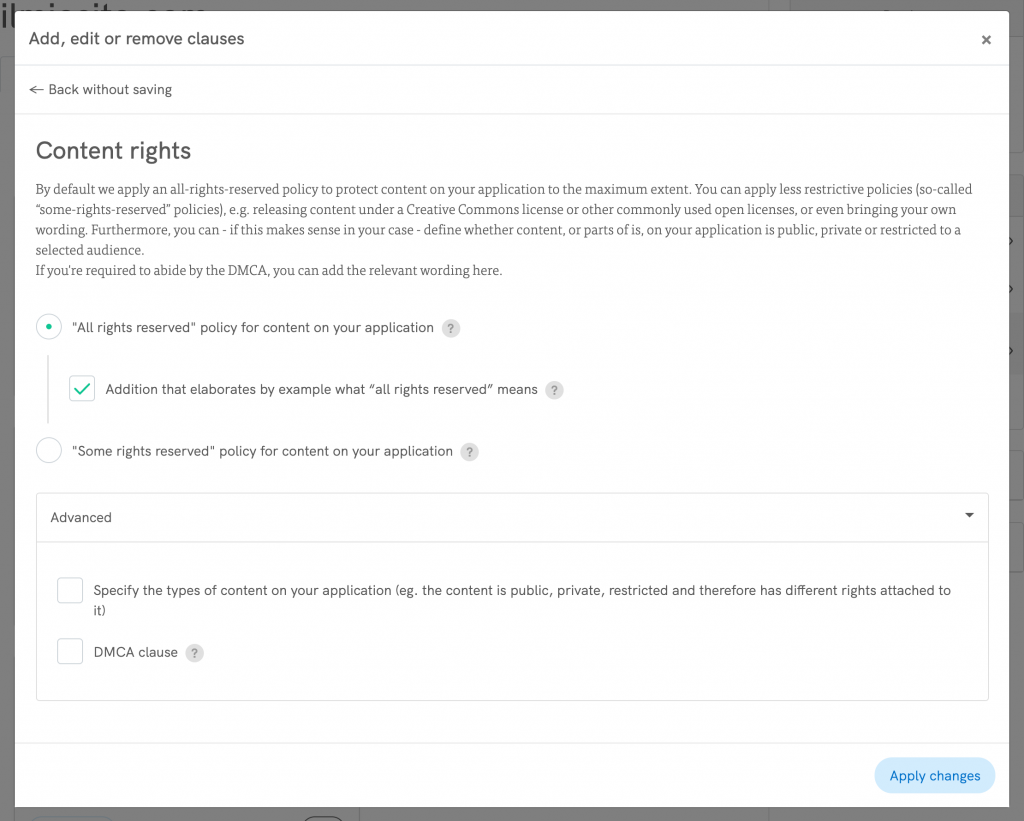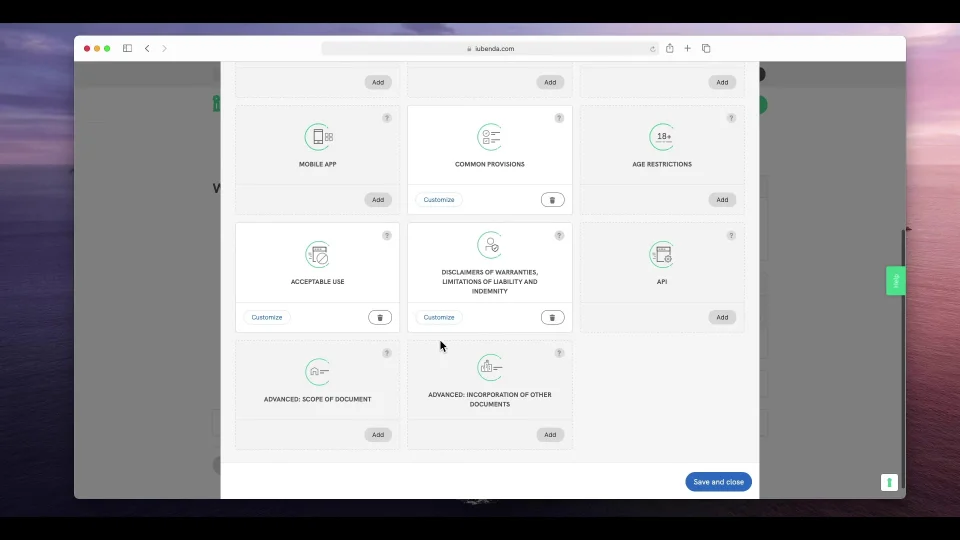Documentation
How to Copyright your Website
Copyrighting web content may seem complicated. You might be asking yourself, how can I copyright my site? Can I use the copyright symbol? What should my copyright notice look like? If this is you, then you’ve come to the right place. In this article, we will take a dive into the world of copyright and give you the needs to know for getting your copyright notice or also known as copyright text. Discover the proper way to copyright your website! Get started now and protect your valuable content.
In short
What is copyright?
Anything sufficiently original that you create, whether that be the next big blockbuster screenplay, best-selling novel, or a blog post, is automatically protected by copyright law. This law protects your work from being used without your authorization or plagiarized allowing you to enforce your rights and in turn maintaining the lawful ownership of your work.
Generate Terms & Conditions for your website
Simple sentences are often not enough to protect your content and intellectual property. That’s why stating your Terms are important. Set things like licensing, Creative Commons, limitations of liability and more.
Try it risk free with our 14-day money-back guarantee
See it in action ^
That being said, copyright applies to creative works, such as – typically – literature, music, film etc., but websites and blogs as such are not always necessarily eligible for copyright protection – rather the single elements used on them such as text, images, sounds, graphic etc. The website/blog as a whole is only eligible for copyright if it itself is the original and creative content rather than just a combination of single copyrightable elements (text, images, sounds, graphic etc.).
Later in this article, we’ll delve into the four components of a copyright text, providing you with more information about each.
Copyright notice: do I need it?
A copyright notice on your website, app, or blog informs users that your content is protected and copyrighted. While copyright notices are not required by law it is strongly recommended to have one in order to help protect your creative content.
A copyright notice on your website, app, or blog informs users that your content is protected and copyrighted. While copyright notices are not required by law it is strongly recommended to have one in order to help protect your creative content.
Sounds good right? But…
More on compliance for bloggers and web publishers
This article is a part of our series on compliance for bloggers and web publishers. Read also:
How do I write a copyright notice for my website?
In the US, copyright notices, also known as copyright text, are usually as follows:
- The word ‘copyright’ or the © symbol
- A date e.g. 2020
- The author’s name (the name of an individual (that could be you), multiple individuals, an organization, business, or corporate name). Please note that copyright owned by legal entities follow different rules and only exists in some countries (e.g. the US)
- A statement of rights (All Rights Reserved / No Rights Reserved*)
*All Rights Reserved. You keep all rights to your material.
No Rights Reserved. No personal copyright. You have ownership but it is not yours alone, meaning the rest of the world can have access. Please note that once you have published your work under a no-rights-reserved policy, there’s basically no way back.

For copyright in the EU:
- “all rights reserved” text or the © symbol
- the year you created the work

A copyright footer is the standard copyright format and most users will look here. If you want a copyright notice for your mobile app you can display your notice in the “About” or “Legal” menu.
💡 Want to know how a copyright disclaimer works and how to write one? 👉 Read our guide on what is a copyright disclaimer and how to write it.
Copyright example: What should your copyright text include?
As we have mentioned before, copyright notices can help protect the original, visual content of your website or blog. This is why most websites include a copyright notice or a line of copyright text in the footer and on each of their pages.
For this, it is crucial to know what to include in your copyright text to protect your creative work. As previously stated, copyright wording should include certain aspects that express your ownership and rights. This lets others know that you have exclusive control over how your work is used. By including these elements in your copyright text, you establish a clear record of your ownership and discourage unauthorized use or reproduction of your content.
Remember, having a copyright sample can be helpful for reference when creating your own copyright text. So let’s see some copyright samples:
Universal Studios copyright text example:

In this copyright example, Universal Studio’s website footer includes a small ©, the date, and the Universal Studios name. In this case, while there is no statement of rights, it is sufficient to indicate that the company has protected the rights of the website.
Fox Media copyright text example:

Fox.com includes a copyright notice that it reserves all rights, and at the same time mentions that they have protected the Trademark in the same notice, at the bottom of the page of their website.
Now that I’ve added a copyright notice to the bottom of my site, do I need to register it?
In most countries, you don’t need to register as copyright is present to the author of any eligible creative work without the need for registration. Keep in mind, that in many countries (e.g. in EU member states), it’s not even possible to register copyrights, however, in the US you can additionally register with the copyright office, which may allow for an easier or broader enforcement of your rights.
💡Remember: never assume that your rights are the same in one country as they are in another, since copyright is territorial. Therefore, you’ll enjoy US-copyright when your work is being used (or infringed upon) in the US, UK-copyright if it’s being used (or infringed upon) in the UK, French copryight in France, Italian copyright in Italy, etc. etc.
Before you go anywhere!
We’ve got to talk about Terms and Conditions
Terms and Conditions are a document that protects the owner (that’s you!) by informing users on how to legally interact with your product, service, or content.
Sounds familiar?
Terms and Conditions are especially important for bloggers and website owners. T&C’s paint a clear picture to users about how they can use your services and content. As this is a legally binding declaration it is protecting your content from a copyright perspective as well as protecting you from potential liabilities.
If you:
- provide advice;
- want to set the rules for user behavior;
- allow your users to upload comments or content;
- have different user levels (eg. registered vs non-registered);
- participate in affiliate programs;
- would like to have some legally enforceable control over, and set rules about, how your product, service, or how users use your content.
You need to set Terms & Conditions.
Help! I need to set Terms and Conditions

Have no fear, here at iubenda we can help you easily generate and manage your T&Cs with our Terms and Conditions Generator:
- customizable from over 100 clauses (including “Content rights”, to protect your content);
- available in 11 languages;
- drafted by an international legal team and up to date with the main international legislations.
The solution works for blogs, eCommerce, and even complex scenarios like marketplace and affiliate scenarios.
